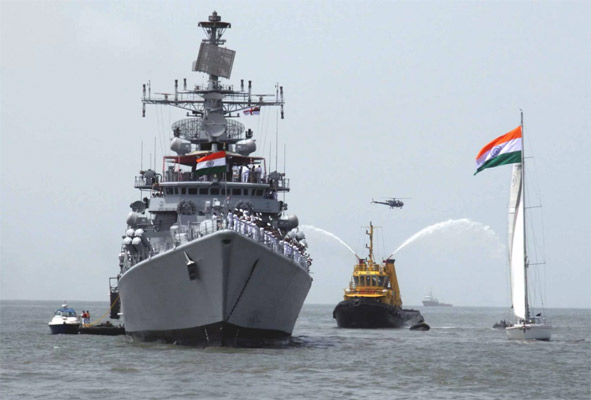Opration Talwar – How The Indian Navy Influenced The Outcome In Kargil
Commodore Anil Jai Singh, IN (Retd)
On 26 July this year, the country commemorated 25 years of its spectacular victory in the Kargil conflict, where the Indian Armed Forces inflicted a major defeat on a determined military, against major odds, to redeem India’s self-esteem and pride. The Indian Army’s young officers, leading from the front, and their soldiers displayed indomitable courage in wresting back the commanding heights which threatened the Indian jugular in Kashmir. This extraordinary saga of courage and determination deserves the highest mention in the annals of warfare. The Indian Air Force too played a stellar role in supporting the Army’s efforts in the Himalayas. The role of both these services got due recognition from the people of India as this was the first conflict being beamed almost live on our television sets by an embedded media.
However, the Indian Navy’s role got less attention. Operating silently, and over the horizon in the vast expanse Arabian Sea a thousand miles from the scene of action, where sagas of heroism were inspiring the nation every single day, the Navy also played a significant part in shaping the outcome of this conflict by degrading the enemy’s war effort in more ways than one, and achieved all this without firing a shot.
The initial reports of the Pakistani infiltration were received in the first week of May 1999. BY 15 May all three services were put on high alert, but the gravity and extent of the infiltration was still not fully known, and was being described as ‘large scale intrusions by Pakistani infiltrators.’ On 25 May, as the gravity of the situation sunk in, the Army launched ‘Operation Vijay’, the Navy ‘Operation Talwar’ and the Air Force ‘Operation Safed Sagar’.
Operation Talwar
The Indian Navy immediately began enhancing its readiness for war and its preparedness to protect its offshore assets from any clandestine pre-emptive action by the Pakistan Navy. Intelligence, surveillance, and reconnaissance operations were enhanced to monitor the movement of PN warships in the North Arabian Sea. By 25 May, the Western fleet, fully armed for war had been deployed for exercises in the North Arabian Sea and adopted a deterrent posture. By the end of May, the Eastern Fleet had also been directed to sail to the west as the navy increased its readiness for an all-out conflict.
In a clever move, photographs of fully armed missile- equipped Eastern Fleet warships in Cochin harbour on the west coast appeared in the nation and international media. This was a smart use of information warfare to put pressure on Pakistan, at a time when this term was barely known. The Western Fleet moved further westward and began conducting EW exercises off Oman. The Pakistan navy also began to prepare itself. Intelligence indicated that it had begun escorting its oil tankers by hugging the Makran Coast. It dispersed its ships from Karachi across all its harbours and the PN was given specific instructions to stay clear of the Indian Navy. Subsequently, as the conflict progressed, Pakistan Navy headquarters directed its ships to stay in harbour. Obviously, the ghosts of India’s lightning strike on the PN Navy on 4th December 1971 (Operation Trident) had not been exorcised from the Pakistani psyche.
Pakistan soon announced that it would deploy its nuclear capable missile -armed ships, which led to the Indian Navy closing in on Karachi. It also intercepted and captured a North Korean merchant ship carrying missile components to Pakistan. By the end of June, India began moving its amphibious forces towards Gao. The presence of such a formidable Indian naval presence off the Pakistani coast acted as a deterrent, with foreign flagged merchant ships fearing a blockade. This kept them away from Karachi and led to a reduction in shipping in the region, thus depriving Pakistan of essential supplies. Pakistan also had just one tanker in its merchant fleet which was grossly inadequate in meeting Pakistan’s requirement of oil. It has been chronicled that Nawaz Sharif admitted that his country was left with barely six days of oil. This degradation in Pakistan’s war effort from the sea was one of the reasons that precipitated the end of the Kargil conflict.
By the end of June, Pakistan was ready to throw in the towel. On 04 July, Nawaz Sharif flew to Washington to meet with President Clinton, and after the meeting announced the Pakistani withdrawal. However, some of the fiercest battles continued after this date, including the recapture of Point 4875 by India. On 26 July, the conflict formally ended. The Indian Navy had exhibited its resolve and intent with its overwhelming deployment of 30 or so powerful warships from both, the Eastern and Western Fleets. The ships were fully armed and ready for a full-fledged war, and were ready to open a front from the south. The rules of engagement were clearly defined for the commanders at sea. Pakistan’s nuclear bluff was successfully called, and the Navy’s restrained, though menacing posture was enough to deliver a decisive outcome at sea without firing a shot.
Author: Commodore Anil Jai Singh, a submarine veteran, is the Vice President of the Indian Maritime Foundation, an Honorary Adjunct Fellow of the National Maritime Foundation and is on the Governing Body of the Society for Indian Ocean Studies.)
Disclaimer – The views and opinions expressed in the commentaries are those of the authors and do not necessarily reflect the official policy or position of Forum for Global Studies

